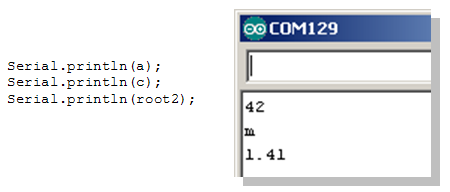
It starts to make a lot more sense once you learn what each letter means, so let’s look at that now. They are simply letters that stand for the kind of data type that will be inserted. The character specifiers are a little weird at first. This means we want two variables inserted into the output string. In this example, we have two format specifiers (%).

The letter following the format specifier is called the format character, and it tells sprintf() what datatype will be used for that variable. The next argument is the string you want to create, filled in with format specifiers where you want to insert your variables. This is where you use the character buffer that you created on the previous line. The first argument is where you plan to store the string that sprintf() will be making for you. Note that sprintf() requires a minimum of 2 arguments. sprintf ( buffer, "The %d burritos are %s degrees F", numBurritos, tempStr )
#ARDUINO PRINTLN COLUMNS CODE#
The next line of code is the actual sprintf() function. Just count the characters you plan to store in that string and make sure the buffer is at least that large. The character array needs to be as large, or larger than the final output string. Let’s take a closer look at each line of code.
#ARDUINO PRINTLN COLUMNS SERIAL#
“The 3 burritos are 147.7 degrees F, weigh 14oz, and were finished 3 minutes ago.”įor every variable you add to the output, you add two more serial prints in the code. What if you wanted to print a line with 4 variables inserted into a string like this: In fact, using Serial.print() to build a string gets even more clunky the more variables you add. But Great Auntie Gertrude’s Carbunkle, is it clunky. Now to be clear, there’s nothing inherently wrong with using Serial.print() to build a string. Using Serial.print() you’d typically write five lines of code to print out that single line of text. In this example, consider both the number of burritos and the temperature value as variables. How would you print a string using text and variables using good old Serial.print()? Let’s say you want to print this line of text to the Serial Monitor: So here’s an Arduino 101 question for you. In this lesson, you’ll learn all the above and a little bit more.įirst, let’s revisit the clunky way to print a string

If that sounds like a handy chunk of knowledge, you’re in the right place. Add that up over a whole project, and it’s a pretty big deal. What would take you nine lines of code with standard serial.print commands you could do in just three using sprintf(). I’ll get into the details shortly, but here’s the main reason you should master sprintf(): It’s your go-to function if you’re looking for a more efficient way to combine text and variables into a string for output to the Serial Monitor. Sprintf() stands for “string print format(ted).

Thus, several experimental tests to confirm the effectiveness of the developed virtual instrumentation system are presented in this study.Sprintf() – Ugly to say, but incredibly useful to master. It is found that our solution presents several benefits compared to the traditional solution such as the data can be presented in graphical form in real time.

A comparison between this low-cost virtual instrumentation and the traditional instrumentation is drawn in this work. Hence, the I-V and P-V characteristics, which processed under real-time conditions, can be obtained directly and plotted on an Excel spreadsheet without needing to reprogram the microcontroller. The acquisition is made through a low-cost current and voltage sensors, and data are presented in Excel by using the PLX-DAQ data acquisition Excel Macro, which allows communication between the ATMega328 microcontroller of an Arduino UNO board and the computer by UART bus. The system design is based on a low-cost Arduino acquisition board. This paper presents a low-cost solution of virtual instrumentation to provide a new technique for real-time instrumentation of the PV panel characteristics such as voltage, current and power.


 0 kommentar(er)
0 kommentar(er)
